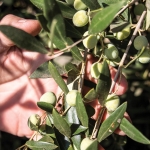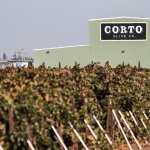Olives grown for extra virgin olive oil are enjoying a resurgence of planting in California, fueled by huge market potential and the fruit’s suitability for mechanical harvest. Jeff Colombini of Lodi Farming, Inc., now has more olives planted than cherries, a move connected to his company’s vertical integration with the establishment of an olive oil mill.
2013 Grower of the Year
Naturally dwarfing varieties are being planted at high densities with 700 to 1,000 trees per acre in hedgerow-style, a training system that can be mechanically pruned and harvested. Two wires are used to hold the trees upright and in line when they are first planted, but the trees themselves don’t really need a trellis system, said Colombini, president of Lodi Farming, a farm management company located in Lodi, California. Lodi Farming produces crops from some 1,800 acres; 450 acres are planted to olives.
According to the California Olive Oil Council, roughly 40,000 acres are now planted in the state for production of extra virgin olive oilmore than the state’s sweet cherry acreage. The crop has been growing around 4 to 6 percent each year. Industry officials project that 2,500 acres will continue to be planted annually through 2020. Growers in Texas, Arizona, and Georgia are also planting trees for olive oil production.
More than 40 olive mills in California produced 2.4 million gallons of extra virgin olive oil from last year’s harvest. This year’s harvest is projected to be around 3 million gallons. Two of the larger olive mills, California Olive Ranch and Corto Olive Company, a sister company to Lodi Farming, are developing successful retail and foodservice markets. Corto Olive produces about 500,000 gallons of olive oil annually.
Colombini sees great opportunity for California growers planting olives for oil. In the last 20 years, consumption by U.S. consumers nearly doubled from 30 million to 70 million gallons of olive oil. “But 99 percent of that is imported,” he said, adding there is great potential to increase consumption of California product.
California extra virgin olive oil producers believe their product is superior in quality to many imported products. To help convey quality to the consumer, the California olive oil industry has developed a seal of certification, designating that the oil meets extra virgin grade requirements. A recent study by the University of California found that 65 percent of imported extra virgin olive oil bought off grocery shelves in the state was falsely labeled as extra virgin grade.
Olives require little labor and water
More Stories |
| – Grower has an open door |
Colombini noted that through trial and error, they are learning where the best locations are in California to grow the crop. “The trees are very sensitive to cold temperatures and don’t do well below 20F,” he said. Moreover, where summer nights are cool, such as in California’s Delta region in the Sacramento area, the trees don’t produce as much oil as in locations with warm nighttime temperatures.
The crop appeals to growers because it requires little labor at harvest time (two workers and one mechanical harvester) and a fraction of the water of other crops. Colombini believes that as water supply and quality problems continue to plague water-thirsty California, more growers will plant olives because of the crop’s low water requirements.
A high-density orchard of around 700 trees per acre will produce about 200 gallons of oil per acre. Harvest timing in California starts in mid-October and ends in December. Harvested fruit is a mix of green and ripe olives–fruit in the black-ripe stage are inferior in quality because they contain more acid and less flavor.
Mechanical harvest
“Growing olives in California for olive oil only works if you can mechanically harvest the crop,” said Colombini. He’s experimented with some varieties that were hand picked and said that the labor costs don’t pencil out. California growers face higher land prices, labor and environmental regulatory costs than others in the world, he said, adding that the industry is focused on producing high-quality extra virgin olive oil.
To mill olive oil, Colombini explained that fruit is ground up, pit and all, to begin the malaxing process. During malaxation, the fruit paste is slowly churned, which encourages the oil to be released. The paste goes through a decanting process, using a centrifuge to extract oil from the paste. The remaining pomace material of skin, pulp, and pits is sold for use in cattle feed formulations.
Extra virgin olive oil, the highest quality and most expensive olive oil classification, must meet a narrowly defined range or grade of oil and be produced entirely by mechanical means, without use of any solvents or extreme heat that would degrade the oil, according to the California Olive Oil Council. Extra virgin olive oil has acidity below 1 percent.
Colombini added that unlike fine wines, peak flavor occurs immediately after production. “Olive oil doesn’t get better with age. It’s at its peak when first pressed.”









Leave A Comment